 |

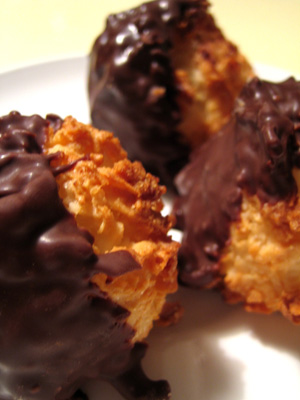 |
| Soft, dense, chewy coconut macaroons dipped in excellent
chocolate are jumbo bites of heaven from Erica’s Rugelach & Baking Co. Photos of Erica’s macaroons by Melody Lan. |
Erica’s Coconut Macaroons:
Loco For Coco
If we wanted to make people happy, we could have gone into business baking our mother’s legendary pies, cakes, brownies and cookies. Instead we took a different route, writing about products from other families’ recipes—this week, the equally legend-worthy macaroons from Erica Kalick’s Great-Aunt Pearl.
Perhaps you have a family member who always arrives for a visit with an armful of homemade baked goods, covered in foil or plastic wrap (so much more welcome than a white bakery box tied with string). Erica’s Rugelach & Baking Co. bridges the gap between the two. The products are homemade-style, but they arrive in non-homey (albeit airtight-for-freshness) plastic containers.
If you love coconut, or know someone who does, look no further: Erica’s macaroons (Great-Aunt Pearl’s recipe) are the ultimate coconut delight. They’re made without flour, so can be enjoyed by those on wheat-free diets. Read the full review below.
We almost hate to call them coconut macaroons because we know what pallid specimens pass for macaroons elsewhere. Dismiss all thoughts of those other coconut macaroons, and focus on the morsels of perfection from Erica’s. Golf ball-sized mounds of dense-but-soft, flaky coconut—baked golden on the outside but snowy white on the inside—are dipped in top-quality chocolate. The result is heaven. Introduce a Mounds lover to them, and he or she will be in your eternal debt.
Erica’s macaroons are so substantive, they can be an event in of themselves, with a cup of coffee or tea. We enjoyed quite a few with a glass of milk. These gems deserve their place:
- On a cookie or pastry plate
- As a snack
- As a dessert—if you wish, you can eat them like a pastry with a knife and fork (follow the coconut’s tropical theme and round out the plate with some sliced tropical fruits: banana, cherimoya, guava, lychee, mango, papaya, persimmon, pineapple, and/or starfruit)
- As a gift (they are available in a gift tin)
Should you be concerned about embracing something so tempting that is so chock-full of coconut?* Not at all. Despite an ingredient list boasting coconut, chocolate, sugar, and sweetened condensed milk (plus egg whites, a dietary “freebie”), Erica’s macaroons are just 120 calories apiece. They are so big, rich and chewy that just one is extremely satisfying.
*Those who think that coconut is “bad for you” should do the research. It isn’t. Not that we eat it as a health food, but the lauric acid and capric acid compounds of coconut are increasingly shown in scientific studies to be antimicrobial and otherwise beneficial.
The History of the Macaroon
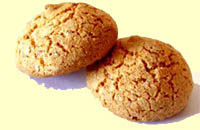 The original macaroons were not coconut; they were almond meringue cookies similar to today’s amaretti, with a crisp crust and a soft interior. They were made from egg whites and almond paste (a combination of equal parts of ground blanched almonds and sugar, mixed with egg whites—today glucose or corn syrup can be substituted). The name of the cookie comes from the Italian word for paste, maccarone (it is also the word for pasta—macaroni—and dumplings). The original macaroons were not coconut; they were almond meringue cookies similar to today’s amaretti, with a crisp crust and a soft interior. They were made from egg whites and almond paste (a combination of equal parts of ground blanched almonds and sugar, mixed with egg whites—today glucose or corn syrup can be substituted). The name of the cookie comes from the Italian word for paste, maccarone (it is also the word for pasta—macaroni—and dumplings).
- While origins can be murky, some culinary historians claim that that macaroons can be traced to an Italian monastery. They came to France in 1533 with the pastry chefs of Catherine de Medici, wife of King Henri II. Two Benedictine nuns, Sister Marguerite and Sister Marie-Elisabeth, seeking asylum in the town of Nancy during the French Revolution (1789-1799), paid for their housing by baking and selling the macaroon cookies, and thus became known as the “Macaroon Sisters” (the French word is macaron).
- Italian Jews adopted the cookie because it has no flour or leavening (the agent that raises and lightens a baked good, like yeast, baking powder and baking soda—instead, macaroons are leavened by egg whites) and can be enjoyed during the eight-day observation of Passover. It was introduced to other European Jews and became popular as a year-round sweet. Over time, coconut was added to the ground almonds and, in certain recipes, replaced them.
- Amaretti, a variant of macaroon, were invented by Francesco Moriondo, pastry chef of the Court of Savoy, in the mid-17th century. They are flavored with chopped bitter almonds or or amaretto, bitter almond liqueur. The Italian word amaro means “bitter,” and the literal translation of amaretti is “the little bitter ones.”
- In Italy, crushed macaroons are used in frangipani, a cream filling made by flavoring butter with lemon extract, rum, sherry or brandy. Macaroon crumbs are often added to ice cream (they are a part of the popular frozen tortoni, named after a 19th century cafe owner), pie fillings and puddings.
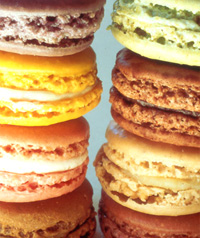 French macarons can be spectacularly colored and flavored meringue “sandwiches.” The concept was invented by Pierre Desfontaines Ladurée, who, at the beginning of the 20th century, had the idea to join two meringues and fill them with ganache. The “originals” combined two plain almond meringues with a filling of [chocolate] ganache; but today ganache, buttercream or jam is sandwiched between meringues of seemingly limitless colors and flavors. The Parisian bakery Ladurée is known for its dozens of exciting flavors. Some, shown in the photo at the right, include Blackcurrant Violet and Salted Butter Caramel, and of course, the basics—Chocolate, Vanilla, Raspberry and Pistachio—plus special seasonal flavors like Anise, Chestnut, Basil Lime, Orange Blossom, Rose and White Chocolate. Every trip to Paris must include a visit! French macarons can be spectacularly colored and flavored meringue “sandwiches.” The concept was invented by Pierre Desfontaines Ladurée, who, at the beginning of the 20th century, had the idea to join two meringues and fill them with ganache. The “originals” combined two plain almond meringues with a filling of [chocolate] ganache; but today ganache, buttercream or jam is sandwiched between meringues of seemingly limitless colors and flavors. The Parisian bakery Ladurée is known for its dozens of exciting flavors. Some, shown in the photo at the right, include Blackcurrant Violet and Salted Butter Caramel, and of course, the basics—Chocolate, Vanilla, Raspberry and Pistachio—plus special seasonal flavors like Anise, Chestnut, Basil Lime, Orange Blossom, Rose and White Chocolate. Every trip to Paris must include a visit! - Macaroons have made their way north to Scandinavia and across the pond. But if you find yourself in France near Poitiers or Limoges, head for the nearby town of Montmorillon and check out the Almond and Macaroon Museum (and let us know all about it).
- Macaroons can be frozen and defrosted 90 minutes before serving.
|
The Italian and French macaroons are lovely, but delicate...airy little cookies that melt in your mouth. You could eat a dozen of them before satiation. But just one of Erica’s Chocolate-Dipped Coconut Macaroons is so satisfying. Two are a feast.
—Karen Hochman
FORWARD THIS NIBBLE to your cookie-loving friends and to parents, grandparents, hosts and hostesses who are always looking for something new and exciting.
ERICA’S RUGELACH & BAKING CO.
Chocolate-Dipped Coconut Macaroons
Certified Kosher (Dairy) by KOF-K
- 7-Ounce Package
6 to 7 pieces
$5.00 (minimum order 4 boxes)
- Gift Tin
1.25 Pounds
$30.00
- Other sizes are available. A price list is online at EricasRugelach.com.
To purchase, telephone 1.718.965.3657, weekdays from 9 a.m. to 5 p.m. Eastern Time. Or, e-mail inquiries to EricasRugelach@aol.com.
Prices and flavor availability are verified at publication but are subject to change. Shipping is additional.
To see more of our favorite cookies, click here.
|
 |
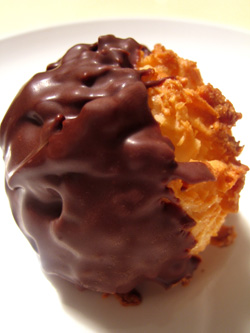
Just one of these golf ball-size macaroons will
satisfy the sweet tooth for an entire day.
|
Jewish Cooking & Baking
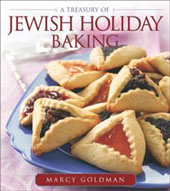 |
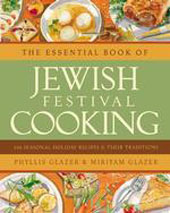 |
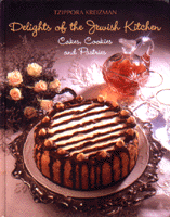 |
| A Treasury of Jewish Holiday Baking, by Marcy Goldman. Get acquainted with basic Jewish food customs and dietary laws, then apply the knowledge and your culinary skills to making traditional Jewish baked goods for particular holidays. Click here for more information. Click here for more information. |
The Essential Book of Jewish Festival Cooking: 200 Seasonal Holiday Recipes and Their Traditions, by Phyllis and Miriyam Glazer. The Glazer sisters fill you in on the foods used to celebrate Jewish festivities with their delicious, easy-to-follow recipes. Click here for more information. |
The Essential Book of Jewish Festival Cooking: 200 Seasonal Holiday Recipes and Their Traditions, by Phyllis and Miriyam Glazer. The Glazer sisters fill you in on the foods used to celebrate Jewish festivities with their delicious, easy-to-follow recipes. Click here for more information. |
FOR ADDITIONAL INFORMATION, special offers,
contests, opinion surveys, THE NIBBLETM
back issues archive, product gift-finder, links to our favorite
food websites, and the ability to nominate YOUR favorite nibbles,
visit the home page of TheNibble.com.
Do you have friends who would enjoy THE NIBBLE?
Click here to send them an invitation to sign up for their own copy. |
ABOUT THE NIBBLE. THE NIBBLE™, Great Food Finds™, is an online magazine plus newsletters about specialty foods and the gourmet life. It is the only consumer publication and website that focuses on reviewing the best specialty foods and beverages, in every category. The magazine also covers tabletop items, gourmet housewares, and other areas of interest to people who love fine food.
© Copyright 2004-2006 Lifestyle Direct, Inc. All rights
reserved. All information contained herein is subject to change at any time
without notice. All details must be directly confirmed with manufacturers, service
establishments and other third parties. The material in this newsletter may not
be reproduced, distributed, transmitted, cached, or otherwise used, except with
the prior written permission of Lifestyle Direct, Inc.
|
 |
|
 |






 The original macaroons were not coconut; they were almond meringue cookies similar to today’s amaretti, with a crisp crust and a soft interior. They were made from egg whites and almond paste (a combination of equal parts of ground blanched almonds and sugar, mixed with egg whites—today glucose or corn syrup can be substituted). The name of the cookie comes from the Italian word for paste, maccarone (it is also the word for pasta—macaroni—and dumplings).
The original macaroons were not coconut; they were almond meringue cookies similar to today’s amaretti, with a crisp crust and a soft interior. They were made from egg whites and almond paste (a combination of equal parts of ground blanched almonds and sugar, mixed with egg whites—today glucose or corn syrup can be substituted). The name of the cookie comes from the Italian word for paste, maccarone (it is also the word for pasta—macaroni—and dumplings). French macarons can be spectacularly colored and flavored meringue “sandwiches.” The concept was invented by Pierre Desfontaines Ladurée, who, at the beginning of the 20th century, had the idea to join two meringues and fill them with ganache. The “originals” combined two plain almond meringues with a filling of [chocolate] ganache; but today ganache, buttercream or jam is sandwiched between meringues of seemingly limitless colors and flavors. The Parisian bakery
French macarons can be spectacularly colored and flavored meringue “sandwiches.” The concept was invented by Pierre Desfontaines Ladurée, who, at the beginning of the 20th century, had the idea to join two meringues and fill them with ganache. The “originals” combined two plain almond meringues with a filling of [chocolate] ganache; but today ganache, buttercream or jam is sandwiched between meringues of seemingly limitless colors and flavors. The Parisian bakery 


